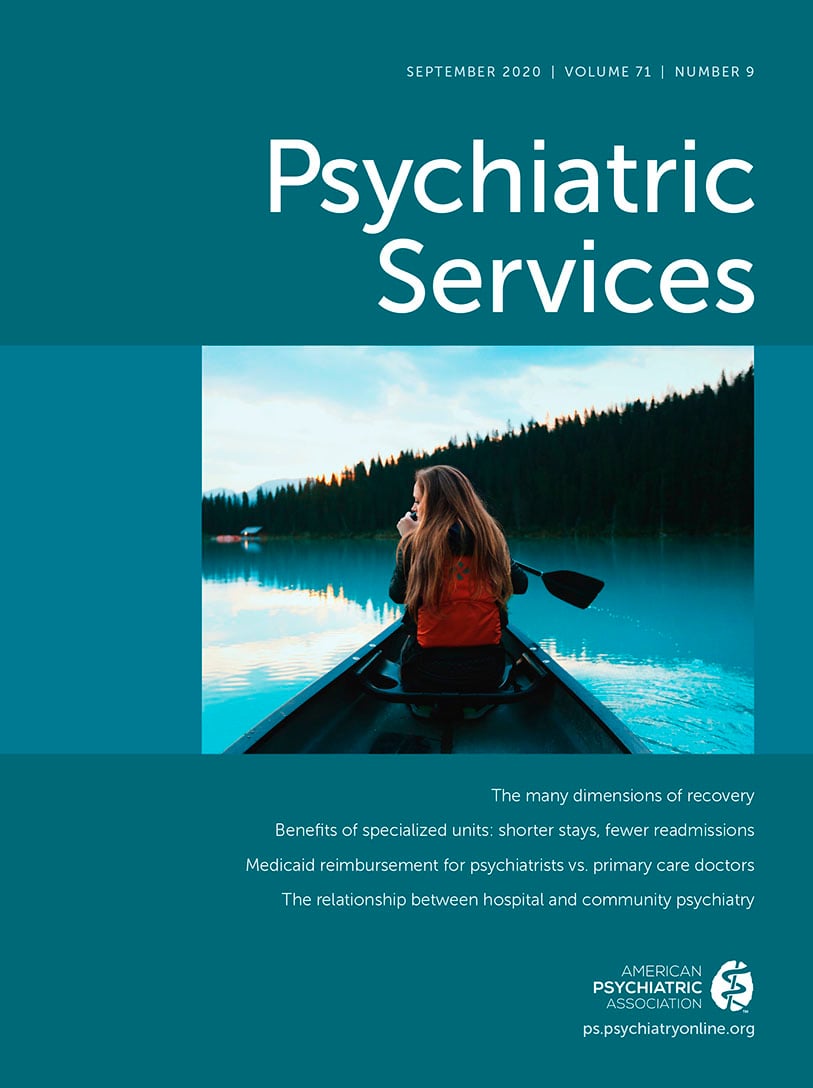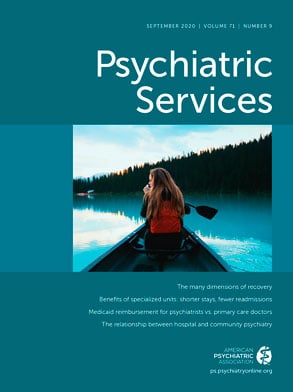In 2019, 64 million individuals were enrolled in Medicaid, of which 20% had a mental or substance use disorder diagnosis (
1). Medicaid beneficiaries’ access to mental health treatment has been limited by the widespread shortage of mental health professionals who are willing to treat patients with Medicaid coverage (
2–
5). For example, even after Medicaid expansions, Wen et al. (
4) found that only 34.8% of psychiatrists were accepting new Medicaid patients in comparison with 71.3% of primary care physicians and 73.3% of physicians in other specialties. One reason physicians are unwilling to accept Medicaid patients is because of low Medicaid reimbursement rates (
3), although the administrative burden of Medicaid programs is also cited as a disincentive for participation (
6).
Increasing psychiatrist reimbursement rates to encourage more Medicaid participation may be challenging as health care costs continue to rise and compose more of federal and state budgets. However, psychiatrists should expect to be reimbursed at least on par with other medical professionals when they provide the same types of services. Nonetheless, a study of private insurance claims data found that psychiatrists were reimbursed less than other physicians for providing the same services to individuals with mental or substance use disorders (
7). Whether psychiatrists are also reimbursed less under Medicaid programs has not yet been evaluated. Therefore, the purpose of this report was to determine whether psychiatrists systematically receive lower reimbursements under Medicaid programs than do primary care physicians.
Methods
The data for this study came from the Medicaid Analytic eXtract (MAX) Other Therapy files. As of 2019, when this study was planned and implemented, the most recent data available were for 2014 and for 17 states. RTI International’s institutional review board deemed this study not to be human subjects research. To be useful for this analysis, a state’s data needed to include provider taxonomy codes to identify clinicians as psychiatrists or primary care physicians. The data also needed to include mental and substance use disorder diagnosis codes and procedure codes. The data in the MAX files for six of the 17 states were missing one or more of these variables too frequently to be included in the study. In five states, more than 75% of all claims were missing a taxonomy code. Therefore, these states were excluded from our analysis. Finally, one state had no claims with a primary (or secondary) mental or substance use disorder diagnosis with payment values (i.e., the state had data for only encounter claims). Accordingly, this state was also excluded from the analysis. Thus, 11 states were included in this study, each of which had reasonably complete data on all data fields essential for the analyses. These 11 states included both states that expanded Medicaid and states that did not.
Among these 11 states, we restricted claims to include only those with a nonfacility place of service code (i.e., codes 02, 19, 21–24, 26, 31, 34, 41, 42, 51–53, 57, or 61). Many states have adopted Medicaid payment policies that mirror Medicare payment policies. Under Medicare payment policies, different fees are applied for facility versus nonfacility status, with larger fees provided for nonfacility claims to account for the additional overhead expenses that a provider operating out of an office setting incurs. We wanted to ensure that any comparison of reimbursements across provider types was not due to differences in the facility versus nonfacility status of each claim. We also excluded encounter claims because the Medicaid payments for these claims were fixed at $0 in the data files. These claims are paid on a capitation basis, and therefore these records do not have a fee-for-service payment associated with them. Less than 1% of records for six of the 11 states were for encounter claims. Among the remaining five states, we omitted less than 50% (N=31,476) of claims in Mississippi, about 50% (N=94,781) of claims in New Jersey, and 70% or more of claims in Michigan (N=739,850), Pennsylvania (N=837,688), and Georgia (N=261,346). Despite the number of claims omitted in these states, a substantial number of claims remained available for analysis.
To determine the appropriate procedure codes to compare psychiatrists with primary care physicians, we first identified the 10 procedure codes most frequently used by psychiatrists and primary care physicians to treat patients with a behavioral health care diagnosis in outpatient settings. In all states, evaluation and management (E&M) codes 99213 (established patient office visit, low to moderate severity) and 99214 (established patient office visit, moderate severity) were among the 10 procedure codes most frequently used by both psychiatrists and primary care physicians (see online supplement). Moreover, these two codes account for about 49% of all behavioral health claims across the 11 states, and we found that they had the most overlap in use by both psychiatrists and primary care physicians. This latter consideration was important because we wanted to isolate whether there were differences in payments across provider types when providers deliver the same services. We then calculated the mean Medicaid payments for these two E&M codes by state for psychiatrists and primary care physicians. We used t tests to determine whether the mean reimbursement rates were statistically significantly different. We used a threshold p value of 0.05 for statistically significant differences and calculated two-sided t statistics and p values. Although the objective of this study was to determine whether psychiatrists are reimbursed less than primary care physicians (a one-sided hypothesis), we chose to use two-sided statistics because this approach is more conservative.
Results
Table 1 shows that in 10 of the 11 states, psychiatrists were reimbursed less than primary care physicians for E&M code 99213, and in 9 of 11 states, psychiatrists were reimbursed less than primary care physicians for code 99214. Primary care physicians were reimbursed $1–$34 more than psychiatrists when billing for E&M code 99213 and were reimbursed $5–$40 more than psychiatrists when billing for E&M code 99214. In Minnesota, primary care physicians were reimbursed $1 less than psychiatrists when billing for E&M code 99214, and in Pennsylvania, primary care physicians were reimbursed $3 less than psychiatrists when billing for E&M code 99213 and $7 less when billing for code 99214. These results include only nonfacility claims. Results were similar when we examined facility claims, with states having higher reimbursement rates for primary care physicians compared with psychiatrists (see
online supplement).
Discussion
In this study, we found that psychiatrists were reimbursed less than primary care physicians for providing the same treatment services to patients with mental or substance use disorders in 9 of the 11 included states. The Medicaid and Children’s Health Insurance Program (CHIP) Payment and Access Commission reports that Medicaid programs generally use one of three methods for establishing physician payment rates: the resource-based relative value scale (RBRVS), a percentage of Medicare’s fee, or a state-developed fee schedule (
8). Medicare RBRVS units and reimbursement rates for E&M codes do not vary by physician specialty. Thus, if states are setting rates by benchmarking to Medicare payment rates or RBRVS units, the variation by psychiatrist and primary care physician is puzzling.
This study suggests that one explanation for why psychiatrists are less likely to participate in Medicaid than primary care physicians, and for why some regions face a shortage of psychiatrists, may be that psychiatrists are reimbursed less than primary care physicians. In fact, this circumstance may be true even in states where average reimbursement is relatively high in comparison with Medicare reimbursements or other national benchmarks. Although primary care physicians can deliver some behavioral health services, they may lack the same training and comfort in treating patients with serious mental and addiction disorders (
9). Thus, it will be challenging to address the lack of psychiatrists by merely substituting behavioral health care delivery with other types of clinicians.
The disparity in reimbursement rates between psychiatrists and primary care physicians is inconsistent with the Mental Health Parity and Addiction Equity Act of 2008 (MHPAEA), which requires that provider reimbursement rates for treating mental and substance use disorders be based on criteria that are comparable to the criteria for setting reimbursement rates for medical providers and applied no more stringently (
10). In fact, guidance from the Centers for Medicare and Medicaid Services (
11) specifically discusses that disparities in provider reimbursements can lead to parity violations. It is important to note that, although MHPAEA applied to Medicaid managed care plans and CHIP as of 2009, the final rule for these health programs was issued in 2016, with compliance required by 2017.
A few limitations were associated with this study. First, this study included only a subset of Medicaid programs and data only from 2014, prior to the final rule applying MHPAEA to Medicaid, because that was the most recently available data as of 2019. As more recent Medicaid claims data become available to researchers, it will be important to replicate this study to incorporate claims from other states and more recent years. Second, this study did not investigate any of the other policies that could lead to low participation rates among psychiatrists, such as administrative burdens associated with participation and billing in Medicaid programs. Third, in three states, a significant number of claims could not be included in the analysis because they were encounter claims and consequently had the payment field administratively fixed at $0. Although the results in these states are based on a proportion of claims, they do not differ significantly from those in the states with no encounter claims.
Conclusions
In this study, we found that in 2014, psychiatrists were reimbursed less than primary care physicians for providing the same treatment services to patients with mental and substance use disorders in 9 of the 11 states analyzed. A key implication of these findings is that reducing reimbursement disparities between psychiatrists and other medical doctors may increase the supply of psychiatrists willing to treat Medicaid patients.

